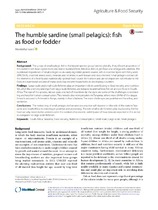| dc.contributor.author | Isaacs, Moenieba | |
| dc.date.accessioned | 2017-06-20T10:08:30Z | |
| dc.date.available | 2017-06-20T10:08:30Z | |
| dc.date.issued | 2016 | |
| dc.identifier.citation | Isaacs Moenieba. (2016). The humble sardine (small pelagics): fish as food or fodder. Agriculture & Food Security, 5:27 | en_US |
| dc.identifier.issn | 20487010 | |
| dc.identifier.uri | http://hdl.handle.net/10566/2993 | |
| dc.identifier.uri | http://dx.doi.org/10.1186/s40066-016-0073-5 | |
| dc.description.abstract | Background: The group of small pelagic fish is the largest species group landed globally. A significant proportion of
this nutrient-rich food is processed and lost to livestock feed, fish feed, fish oil, pet food and omega-rich vitamins. The
nutritional importance of small pelagics as an easily digestible protein source, rich in essential lipids with fatty acids
(EPA/DHA), essential amino acids, minerals and vitamins, is well known and documented. Small pelagics contain all
the elements of a healthy and nutritionally optimal food source for humans and are an important contributor to the
food and nutritional security of many poor, low-income households in developing countries.
Findings: Large-scale and small-scale fisheries play an important role in contributing to food security and nutrition.
Yet, all of the anchovy landings from large-scale fisheries are reduced to animal feed, fish oil and pet food in South
Africa. The size of the species, labour costs and lack of incentives by the state are some of the challenges to redirecting
anchovy for human consumption. This trend is also now prevalent in Tanzania, where most (84%) of the dagaa
fished is reduced to fishmeal in Kenya, mainly to feed chickens. The main challenges are post-harvest handling and
sanitation.
Conclusions: The redirecting of small pelagics to human consumption will depend on the role of the state in Tanzania
and South Africa in investing in post-harvest processing. The role small-scale fisheries play in providing fish for
food security needs to be understood in the context of economic viability and of how data are reported in this sector
as compared to large-scale fisheries. | en_US |
| dc.language.iso | en | en_US |
| dc.publisher | BioMed Central Ltd. | |
| dc.rights | All the contents of this journal, except where otherwise noted, is licensed under a Creative Commons Attribution License | |
| dc.subject | South Africa | en_US |
| dc.subject | Tanzania | en_US |
| dc.subject | Food security | en_US |
| dc.subject | Nutrition | en_US |
| dc.subject | Consumption | en_US |
| dc.subject | Small-scale | en_US |
| dc.subject | Large-scale | en_US |
| dc.subject | Small pelagics | en_US |
| dc.title | The humble sardine (small pelagics): fish as food or fodder | en_US |
| dc.type | Article | en_US |
| dc.description.accreditation | Scopus 2017 | |

